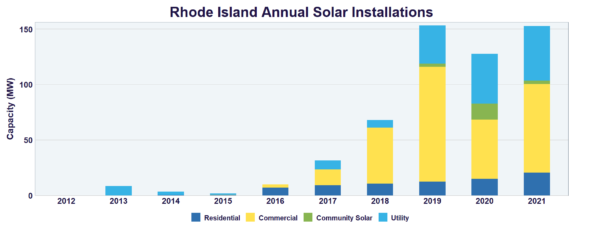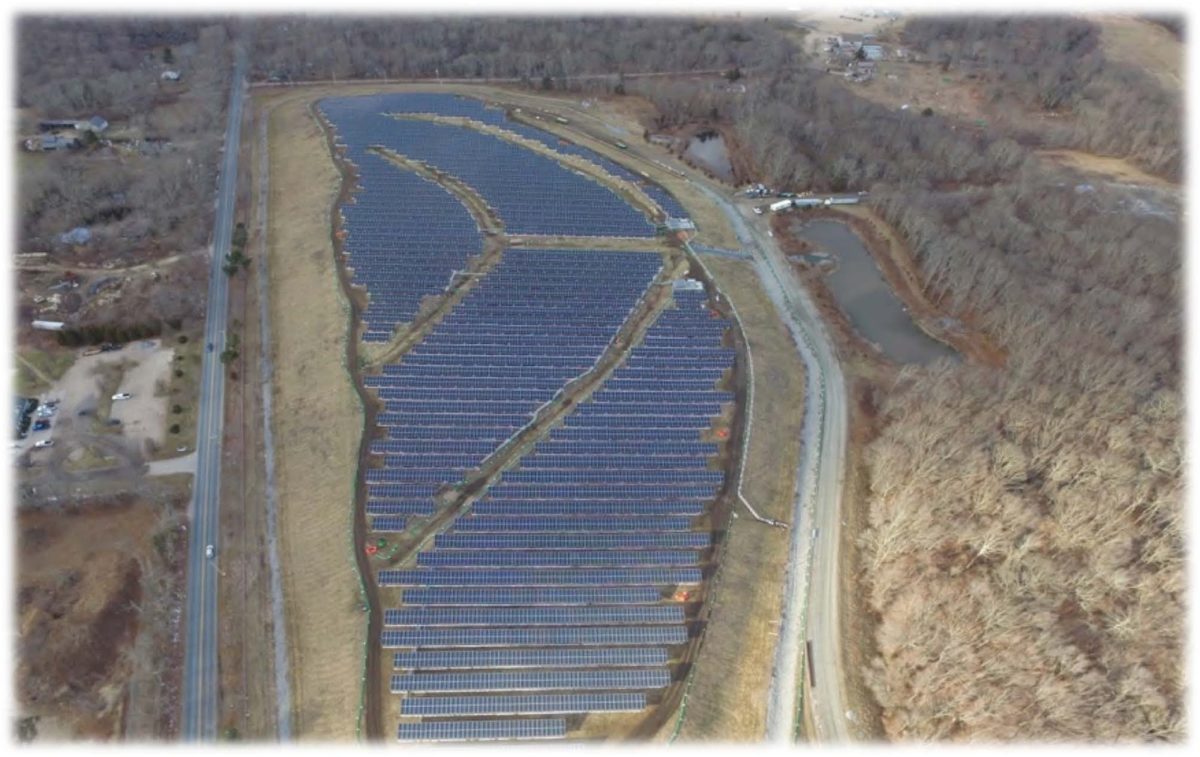Two years ago, Rhode Island was the first state in the nation to set a goal to meet 100% of its electricity demand with renewable energy by 2030. The Rhode Island Office of Energy Resources conducted an economic and energy market analysis, and developed policy and plant to meet this goal. Going a step further, last year Governor Dan McKee signed into law the 2021 Act on Climate, which sets mandatory, enforceable climate emissions reduction goals needed for the state to achieve net-zero emissions economy-wide by 2050.
With 555.4 MW currently installed, Rhode Island is ranked 29th in country for solar. According to the EIA, Rhode Island residents consume less energy on a per capita basis than any other state and, perhaps as testament to residents’ low electricity use, solar is covering nearly 9% of their electricity needs. The growth projection, according to SEIA, is an additional 438 MW of solar over the next five years.
High electric bills are the impetus for many New Englanders to go solar, as these six northeast states have some of the highest electric rates in the country. Rhode Island has the second highest rates in New England, at 23.56 cents per kWh, an increase of .6% in the past year. This is just behind the Massachusetts rate of 25.28 cents per kWh, due to jump a whopping 13.3%. The EIA reports that In 2020, natural gas fueled 89% of Rhode Island’s electricity net generation, the largest share of any state.
Tax credits and exemptions
For those who seize the opportunity to go solar in United States, the federal Investment Tax Credit (ITC) is currently 26% of system costs. Rhode Island goes a bit further. In 2016 the state passed a bill that exempts qualifying renewable energy systems and associated equipment from property taxes. Qualifying systems include direct solar radiation, wind, ocean, geothermal, small hydro, eligible biomass fuels and fuels cells using renewable resources.
The state also has a feed-in tariff program that could arguably be a model for the nation. The Rhode Island Renewable Energy Growth (REGrowth) program offers a 20-year feed-in tariff for non-residential renewable energy projects sized between 25 kW and 5 MW. The program is designed to optimize the price of electricity paid by electricity users. Project owners bid their project price per kilowatt-hour up to a ceiling amount that is designed to be lowered each year. Each solar project must be a standalone system, meaning that it has to have its own electricity meter and sell 100% of its power directly to the electric utility.
An upside to the program is that it allows the owner/occupants to produce as much solar as the roof can support, with 100% of the energy sold to the power grid. But there are a few challenges that have to do with timing and risk, as discussed in “A look inside Rhode Island’s Most successful solar incentive program.”

Net metering
Net metering rules in Rhode Island allow customers to receive credit on electric bills for all power generated up to 125% of the on-site consumption during a billing period. Public entities (municipal, state, quasi-state) are allowed to enter into virtual net metering arrangements with renewable energy developers for up to 10 MW per project site.
Low income
Zero Energy for the Ocean State (ZEOS) is a program that incentivizes zero energy designs that bring cost savings to lower income residents. In a public-sector partnership between OER (DEFINE) and RIHousing have committee $750,000 in funding to three developers to produce a range of building types that ensure replicability of their zero energy designs. One of the projects, Brookside Terrace II, built by Dakota Partners, is a 48-unit rental development in East Greenwich available to households earning less than 60% Area Median Income (AMI). Another project is Bourne Mills III, built by The Armory Revival Company, a 59-unit apartment building in Tiverton. 47 of the units are restricted to households earning 120% or less AMI.
Community solar
Rhode Island also allows Community Choice Aggregation (CEA), a program that allows a town to buy electricity in bulk with the goal of increasing the renewable content of that electricity. Barrington, Central Falls, Providence and South Kingstown have received approval from the Public Utilities Commission for the program as of May 2021
The state also allows community solar, which is a solar installation shared by more than one household. Its primary purpose is to allow members of a community the opportunity to share the benefits of solar power even if they cannot install solar panels on their property. There are currently 17 community solar projects in the state with 6,240 households signed up for them. Five are virtual net metering and twelve Community Remote Distributed Generation community solar projects.
Clean energy goals
Rhode Island’s Renewable Energy Standard (RES) was established in June 2004 and requires retail electricity probers to supply 38.5% of their retail electricity sales from renewables by 2035. The requirement increases each year—right now the rate of increase is 1.5% through 2025. One caveat is that the PUC can delay the planned increase if it determines that there’s an inadequate of supply of renewable energy to meet the increase requirement.
Rhode Island’s nickname is the Ocean State, so it’s not surprising that harnessing wind energy is part of its clean energy plan. As of September 31, 2021, the state had installed approximately 1,017 MW of clean energy generation capacity, of which 430 MW was offshore wind, 399 MW solar, 144 MW onshore wind, 35 MW is landfill gas/anaerobic digestion, and 9 MW is small hydroelectric power. The Revolution Wind project, which will be located 15 miles off the Rhode Island coast and expected to be operational in 2025, will supply 400 MW of clean energy to the state. With this addition, wind – both onshore and off—will be the predominant source of renewable energy for the state.
Solar installations, however, in the tiny state of Rhode Island are not insignificant. Many of the solar farms in the state have been relatively small, for example: old Meadow Farms, 16.2 MW; Brown University Dry Bridge Solar, 10 MW; and Alton Road Solar, 13.9 MW. By far the largest portfolio to date is the University Solar project with CS Energy, which was contracted to engineer, procure, and construct a 50.7 MW portfolio of co-located ground mounted solar arrays on a former sand and gravel pit in North Kingstown.
With strong solar policies and an aggressive goal of 100% renewable by 2030, Rhode Island is on pace to meet SEIA’s projection for the growth of solar in Rhode Island, which anticipates an additional 438 MW over the next five years.
Last time on the 50 states of solar incentives tour, pv magazine reviewed Rhode Island’s neighbor of Massachusetts. Next, we will travel to Vermont, concluding the tour of the New England region.
This content is protected by copyright and may not be reused. If you want to cooperate with us and would like to reuse some of our content, please contact: editors@pv-magazine.com.









By submitting this form you agree to pv magazine using your data for the purposes of publishing your comment.
Your personal data will only be disclosed or otherwise transmitted to third parties for the purposes of spam filtering or if this is necessary for technical maintenance of the website. Any other transfer to third parties will not take place unless this is justified on the basis of applicable data protection regulations or if pv magazine is legally obliged to do so.
You may revoke this consent at any time with effect for the future, in which case your personal data will be deleted immediately. Otherwise, your data will be deleted if pv magazine has processed your request or the purpose of data storage is fulfilled.
Further information on data privacy can be found in our Data Protection Policy.